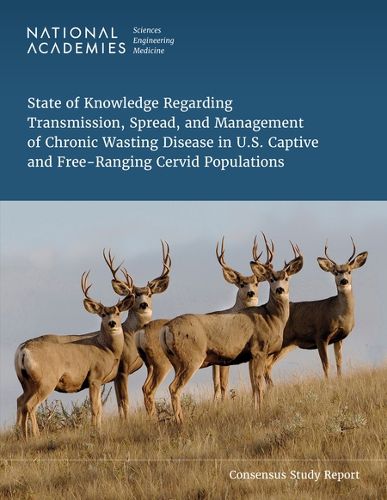Readings Newsletter
Become a Readings Member to make your shopping experience even easier.
Sign in or sign up for free!
You’re not far away from qualifying for FREE standard shipping within Australia
You’ve qualified for FREE standard shipping within Australia
The cart is loading…






Chronic wasting disease (CWD) is a fatal, infectious prion disease affecting the central nervous system of some species of Cervidae-animals such as deer, elk, and moose. Recognized as a disease in the 1980s but suspected to have been present in the United States for decades longer, CWD affects both captive and free-ranging cervids and has been reported in 35 states and five Canadian provinces of North America as of August 1, 2024. The potential ramifications of the increasing spread of CWD are serious, and include negative impacts on ecosystems, and large economic costs for agencies with management responsibilities related to cervids and for industries that depend on cervids or cervid products. Cultural and food security impacts for communities with traditions tied to cervid hunting are also impacted.
In 2020, Congress passed America's Conservation Enhancement (ACE) Act (P.L. 116-188), directing the U.S. Fish and Wildlife Service to lead a task force for addressing CWD in the United States drawing on a study commissioned from the National Academies. This report will assist the task force in prioritizing research and developing future CWD management strategies. It describes the state of knowledge regarding how CWD is transmitted among cervids, the current distribution of disease outbreaks, and the effectiveness of current diagnostic, prevention, and control methods available to limit the spread of the disease.
Table of Contents
Front Matter Summary 1 Introduction 2 CWD Description, Pathogenesis, and Infectivity 3 Mechanisms of Transmission and Potential Host Range 4 Diagnostics and Surveillance 5 Epidemiology and Ecology of Chronic Wasting Disease 6 Effectiveness of Interventions to Control or Reduce the Transmission and Spread of CWD in Captive and Free-Ranging Cervids 7 The Human and Socioeconomic Dimensions of CWD 8 Future Considerations References Appendix A: Committee Biographical Information Appendix B: Public Meeting Agendas Appendix C: Commonly Asked Questions Appendix D: Published Diagnostic Testing Platforms Appendix E: Supplementary Information on Other Transmissible Spongiform Encephalopathies (TSEs) and Their Economic Impacts Appendix F: Data on Cervid Farms and Captive Cervids by State and Costs
$9.00 standard shipping within Australia
FREE standard shipping within Australia for orders over $100.00
Express & International shipping calculated at checkout
Stock availability can be subject to change without notice. We recommend calling the shop or contacting our online team to check availability of low stock items. Please see our Shopping Online page for more details.
Chronic wasting disease (CWD) is a fatal, infectious prion disease affecting the central nervous system of some species of Cervidae-animals such as deer, elk, and moose. Recognized as a disease in the 1980s but suspected to have been present in the United States for decades longer, CWD affects both captive and free-ranging cervids and has been reported in 35 states and five Canadian provinces of North America as of August 1, 2024. The potential ramifications of the increasing spread of CWD are serious, and include negative impacts on ecosystems, and large economic costs for agencies with management responsibilities related to cervids and for industries that depend on cervids or cervid products. Cultural and food security impacts for communities with traditions tied to cervid hunting are also impacted.
In 2020, Congress passed America's Conservation Enhancement (ACE) Act (P.L. 116-188), directing the U.S. Fish and Wildlife Service to lead a task force for addressing CWD in the United States drawing on a study commissioned from the National Academies. This report will assist the task force in prioritizing research and developing future CWD management strategies. It describes the state of knowledge regarding how CWD is transmitted among cervids, the current distribution of disease outbreaks, and the effectiveness of current diagnostic, prevention, and control methods available to limit the spread of the disease.
Table of Contents
Front Matter Summary 1 Introduction 2 CWD Description, Pathogenesis, and Infectivity 3 Mechanisms of Transmission and Potential Host Range 4 Diagnostics and Surveillance 5 Epidemiology and Ecology of Chronic Wasting Disease 6 Effectiveness of Interventions to Control or Reduce the Transmission and Spread of CWD in Captive and Free-Ranging Cervids 7 The Human and Socioeconomic Dimensions of CWD 8 Future Considerations References Appendix A: Committee Biographical Information Appendix B: Public Meeting Agendas Appendix C: Commonly Asked Questions Appendix D: Published Diagnostic Testing Platforms Appendix E: Supplementary Information on Other Transmissible Spongiform Encephalopathies (TSEs) and Their Economic Impacts Appendix F: Data on Cervid Farms and Captive Cervids by State and Costs